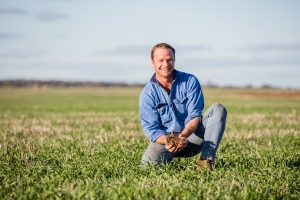Better soil testing could ‘save dollars on-farm’
Better soil testing could ‘save dollars on-farm’
Date: 07 Jul 2021

A leading soil scientist is calling for an urgent rethink of how soil constraints are assessed with concern that an over-reliance on a commonly used soil test is resulting in costly and ineffective soil management strategies on-farm 38 per cent of the time.
University of Southern Queensland’s (USQ) Professor John Bennett is leading a $3.3 million Grains Research and Development Corporation (GRDC) investment – the economics of ameliorating soil constraints in the northern region – investigating strategies to overcome two key constraints, dispersive and compacted soils.
Now research findings from the five-year project, which also involves research partners the Department of Agriculture and Fisheries (DAF) and the University of New England (UNE), have delivered new understanding to when growers should use gypsum to improve ‘sodic’ soils.
Professor Bennett said the grains industry had traditionally used exchangeable sodium percentage (ESP) tests to determine a soil’s sodicity and dispersiveness, which was then used to inform the gypsum application.
Traditionally, where the ESP has been greater than five per cent, gypsum application has been recommended to correct dispersion. Dispersive soils have structural instability which often result in surface crusting; a reduction in infiltration, soil water storage and availability; increased run-off; and associated poor crop emergence and yield.
Sodic soils tend to be naturally occurring and refer to the presence of too much sodium in the soil. As the level of sodium increases plant nutrients such as calcium, magnesium and potassium can be diminished.
“Growers and farm advisers have tended to use the terms sodic and dispersive interchangeably,” Professor Bennett said.
“However, importantly this new research has reinforced that not all sodic soils are dispersive. So, relying on an ESP test alone to determine whether gypsum is needed is inaccurate and is costing growers in terms of unnecessary soil input costs that won’t translate to yield gains.”
As part of this research, Professor Bennett and University of Southern Queensland researcher Dr Stirling Roberton assessed 61 farms. Of those, 75 per cent were considered sodic when ESP tests were used. However, only 48 per cent were found to have sodic soils that were also dispersive soils.
“This is a huge error rate. Of all soils assessed as being dispersive using the ESP criterion, 38 per cent would be incorrectly diagnosed,” Professor Bennet said.
“This has economic consequences for growers who apply gypsum where it is not needed. It also erodes confidence in gypsum use.”
As a result of this new data Professor Bennett and his team are pushing for a standard ‘dispersion test to measure soil stability’ to be introduced as part of on-farm soil analysis.
“An ESP test will still be carried out – to calculate the amount of gypsum needed – but a gypsum recommendation will only be made where dispersion is observed,” he said.
Professor Bennett said this two-step approach would result in better testing, diagnosis and management plans. Already, he has convinced two major agronomy companies to change their testing process, demonstrating the cost of wasted application and unrealised potential yield.
“Gypsum can cost more than $120 per hectare spread so we need to get it right. Comparatively, the cost of dispersion analysis can be as little as $4.5 per hectare, depending on the sampling density,” he said.
“As soil scientists we need to help implement a robust and comprehensive system for professionally assessing dispersive soil in a way that ensures that expensive gypsum and/or lime application actually does provide profitable crop responses.”
Northern NSW grain grower Jack Pearlman has already benefited from the research findings thanks to a GRDC trial on his family property near North Star.
The grower, who farms 3300 hectares with his parents, Michael and Kylie, had planned to apply gypsum to about 185ha to address what he believed were sodicity issues at an estimated cost of $300/ha.
But before he applied the gypsum, he sent soil samples to Dr Roberton and Professor Bennett.
“In just 15 minutes, with an aggregate stability test, they saved us more than $50,000,” Jack said.
Professor Bennett said the Pearlman’s experience highlights the importance of accurate soil constraint diagnosis before investing in amelioration. His team is now working with Mr Pearlman and other growers involved in the GRDC on-farm trials to develop variable-rate gypsum plans.
“The work we have done with Jack highlights the importance of accurate soil constraint diagnosis. If done properly, we can help map areas of the farm which offer the best return on investment for soil amelioration,” he said.
For more information about the project go to GroundCover online.
Or check out the GRDC 2021 Update paper on Amelioration for sodicity – deep ripping and soil amendment addition across NSW and Queensland. A recording of Stirling Roberton’s presentation on soil amelioration from the 2021 GRDC Grains Research at Dalby is also available.
Contact details
Contact
Toni Somes, GRDC Communications Manager – North
0436 622 645
toni.somes@grdc.com.au
GRDC Project Code: USQ1803-002RTX,
